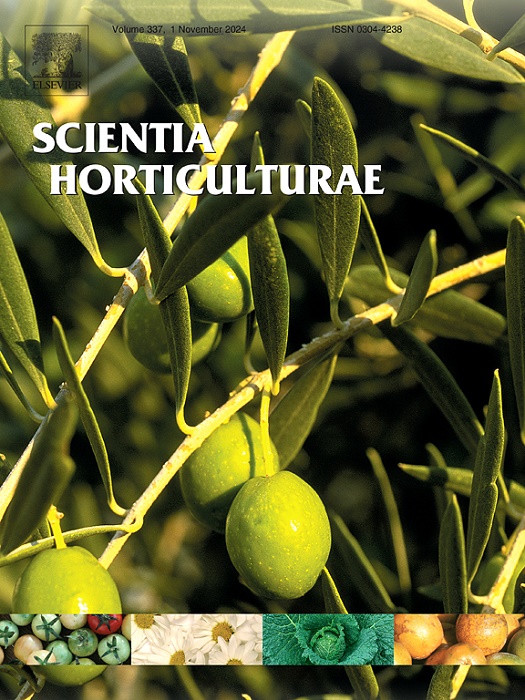百合单倍体植株生产及流式细胞术评价
IF 3.9
2区 农林科学
Q1 HORTICULTURE
引用次数: 0
摘要
布伊斯百合。是一种独特的观赏植物,其育种计划具有重要意义。由于其野生性,对这种稀有植物的栽培研究有限。本研究旨在评估生长调节剂组合对L. ledebourii愈伤组织发生、胚胎发生和花药培养再生植株的影响,同时评估再生植株的倍性水平。实验采用因子设计,采用完全随机设置,有5个重复。在MS、B5和NLN培养基中添加3%蔗糖和2,4- d(0、0.5、1、2和4mg /L)和噻脲(TDZ)(0、0.5、1、2和4mg /L),开始形成Callogenesis。用Picloram(0、0.5、1、2和4mg /L)和Kinetin(0、0.5、1、2和4mg /L)在NLN培养基中诱导胚胎发生。在无激素的固体NLN上促进再生。将处理后的愈伤组织转移到胚发生培养基上,进行黑暗处理以促进胚胎发育。结果显示NLN。愈伤组织诱导率最高(28.57%),B5次之(24.06%),MS最低(13.41%)。NLN产生的愈伤组织最大,其次是B5, MS培养基产生的愈伤组织最小。2,4-D和TDZ的最佳激素组合为1 mg/L,愈伤组织诱导率为79.68%,愈伤组织大小为44.4 mm。2 mg/L的Pic和1 mg/L的Kn的胚胎发生率最高,为76.65%。再生小球的倍性水平评估显示三个单倍体小球,其余为二倍体,与对照一致,通过染色体计数确定,并通过流式细胞术证实。综上所述,本研究提出的花药培养方案有望产生纯合子l.l ledebourii植株。本文章由计算机程序翻译,如有差异,请以英文原文为准。
Haploid plant production and flowcytometric evaluation of Lilium ledebourii (Baker) Boiss
Lilium ledebourii (Baker) Boiss. is a distinct ornamental species, with its breeding program being of significant importance. Due to its wild nature, cultivation of this rare plant has been explored in limited studies. This investigation aimed to assess the impact of growth regulator combinations on callogenesis, embryogenesis, and regeneration of L. ledebourii through anther culture, alongside evaluating the ploidy level of the regenerated plants. The experiment followed a factorial design, employing a wholly randomized setup with five replications. Callogenesis was initiated using MS, B5, and NLN culture media supplemented with 3 % sucrose and 2,4-D (0, 0.5, 1, 2, and 4 mg/L) and thidiazuron (TDZ) (0, 0.5, 1, 2, and 4 mg/L). Embryogenesis was induced using Picloram (Pic) (0, 0.5, 1, 2, and 4 mg/L) and Kinetin (Kn) (0, 0.5, 1, 2, and 4 mg/L) in NLN medium. Regeneration was facilitated on a solid, hormone-free NLN. Calli obtained from the treatments were transferred to an embryogenesis medium and subjected to darkness treatment to foster embryo development. Results revealed that NLN. yielded the highest rate of callus induction (28.57 %), followed by B5 (24.06 %), with MS medium yielding the lowest (13.41 %). The NLN yielded the largest callus size, followed by B5, while the MS medium yielded the smallest. The optimal hormonal combination for callogenesis comprised 1 mg/L of 2,4-D and 1 mg/L of TDZ, achieving a callus induction percentage of 79.68 % and a callus size of 44.4 mm. The highest embryogenesis percentage (76.65 %) was attained with 2 mg/L of Pic and 1 mg/L of Kn. Ploidy level evaluation of the regenerated bulblets revealed three haploid bulblets, the remainder being diploid, consistent with the control, determined through chromosome count, and confirmed by flow cytometry. In summary, the anther culture protocol proposed in this study holds promise for producing homozygous L. ledebourii plants.
求助全文
通过发布文献求助,成功后即可免费获取论文全文。
去求助
来源期刊

Scientia Horticulturae
农林科学-园艺
CiteScore
8.60
自引率
4.70%
发文量
796
审稿时长
47 days
期刊介绍:
Scientia Horticulturae is an international journal publishing research related to horticultural crops. Articles in the journal deal with open or protected production of vegetables, fruits, edible fungi and ornamentals under temperate, subtropical and tropical conditions. Papers in related areas (biochemistry, micropropagation, soil science, plant breeding, plant physiology, phytopathology, etc.) are considered, if they contain information of direct significance to horticulture. Papers on the technical aspects of horticulture (engineering, crop processing, storage, transport etc.) are accepted for publication only if they relate directly to the living product. In the case of plantation crops, those yielding a product that may be used fresh (e.g. tropical vegetables, citrus, bananas, and other fruits) will be considered, while those papers describing the processing of the product (e.g. rubber, tobacco, and quinine) will not. The scope of the journal includes all horticultural crops but does not include speciality crops such as, medicinal crops or forestry crops, such as bamboo. Basic molecular studies without any direct application in horticulture will not be considered for this journal.
 求助内容:
求助内容: 应助结果提醒方式:
应助结果提醒方式:


